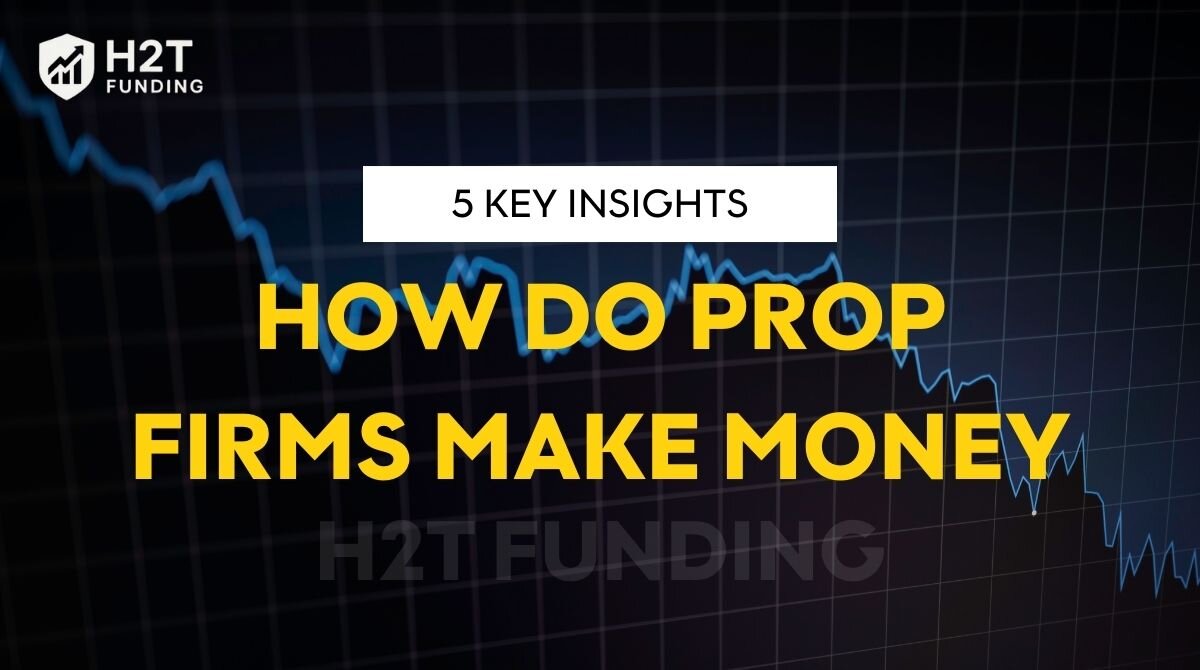If you’ve ever wondered how do prop firms make money, the answer goes beyond just funding traders. From my own experience and research, prop firms survive by diversifying several steady revenue streams, ensuring they earn a profit regardless of whether a trader wins or loses.
Here’s what I’ve seen most often:
- Evaluation fees: Traders pay upfront to join challenges.
- Profit splits: Even in success, traders usually share 10–30% of profits.
- Reset or extension fees: Charged for rule breaks or extra time.
- Extra services: Advanced tools, data, and education often come at a price.
- Market returns: Firms also trade their own capital or benefit from spreads.
Understanding how do prop firms make money helps you see the bigger picture: it’s a system built to profit consistently, not just from your trades. H2T Funding lifts the curtain on these mechanisms so you can approach prop trading with eyes wide open, aware, confident, and ready for the emotional highs and lows of this challenging path.
Let’s find out together!
Key takeaways
- A prop firm is a company that uses its own capital to fund traders, requiring them to pass an evaluation and share profits, creating both opportunity and revenue.
- The business model of prop firms relies on challenge fees, service add-ons, and profit sharing, ensuring steady cash flow even when traders lose.
- Their profitability is sustained through low pass rates, demo-based accounts, and strict risk control systems supported by AI fraud detection.
- Traders gain access to large capital without an upfront deposit, but must face time pressure, strict rules, and limited trading styles, demanding strong discipline and psychological resilience.
1. What is a prop firm?
A prop firm, or proprietary trading firm, is a company that funds traders with its own capital instead of requiring them to risk personal money. Traders must usually pass an evaluation to prove their skills, then share a portion of profits with the firm. This setup allows individuals to access larger accounts while the firm earns through fees and profit splits.
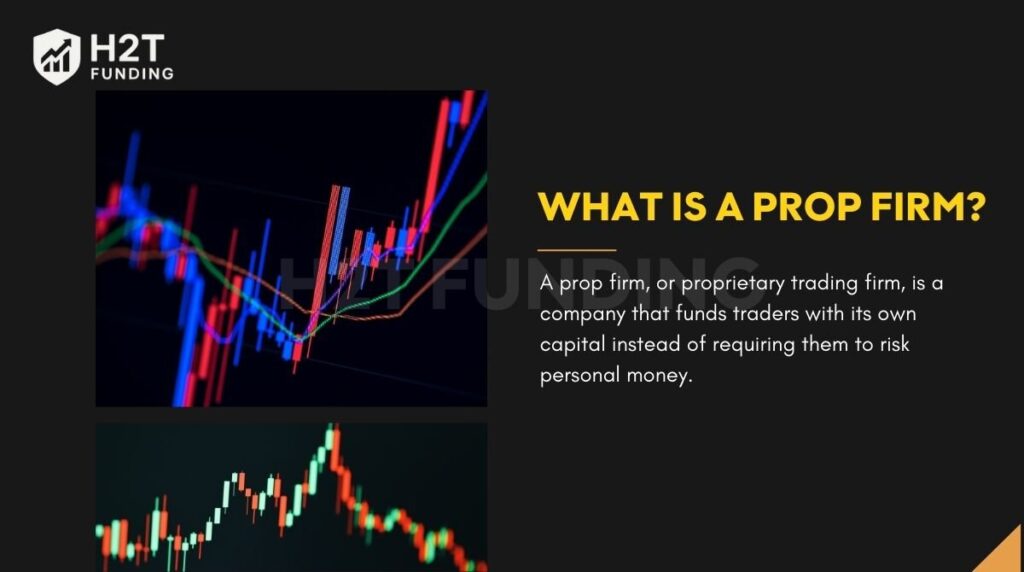
2. How do prop firms make money
While many prop firms claim they only profit when their traders succeed, the reality is more complex. Understanding how do prop firms make money reveals a hybrid model, built on fees, profit splits, and added services, that ensures firms earn steadily, even when traders face losses or setbacks.
To see this clearly, it helps to compare prop firms with traditional brokers:
| Criteria | Traditional brokers | Prop firms |
|---|---|---|
| Capital source | Clients deposit and trade with their own funds | The firm’s own capital is allocated to selected traders |
| Revenue model | Spreads, commissions, overnight fees, and transaction-based income | Profit sharing from traders’ gains, plus evaluation or service fees |
| Trader’s risk | The trader bears 100% of the trading risk | Trading risk is primarily borne by the firm, but managed with strict rules |
| Objective | Maximize trade volume and client activity | Maximize profitability from skilled, disciplined traders |
| Access to capital | Limited to the trader’s personal funds | Access to significantly larger trading capital after passing the evaluation |
This fundamental difference explains why prop firms can provide traders with opportunities without requiring personal capital. The firm does take on financial risk, but only after filtering out inconsistent or high-risk strategies through a rigorous selection process.
The typical recruitment path usually includes:
- Evaluation phase: Hitting profit targets while following strict rules.
- Verification phase: Proving consistent performance over time.
- Funded account stage: Accessing live capital under a profit-sharing agreement.
By combining access to significant trading capital with a careful screening process, prop firms balance opportunity with risk control. This ensures the setup remains mutually beneficial: traders get a chance to scale up, while firms protect their capital and maintain profitability.
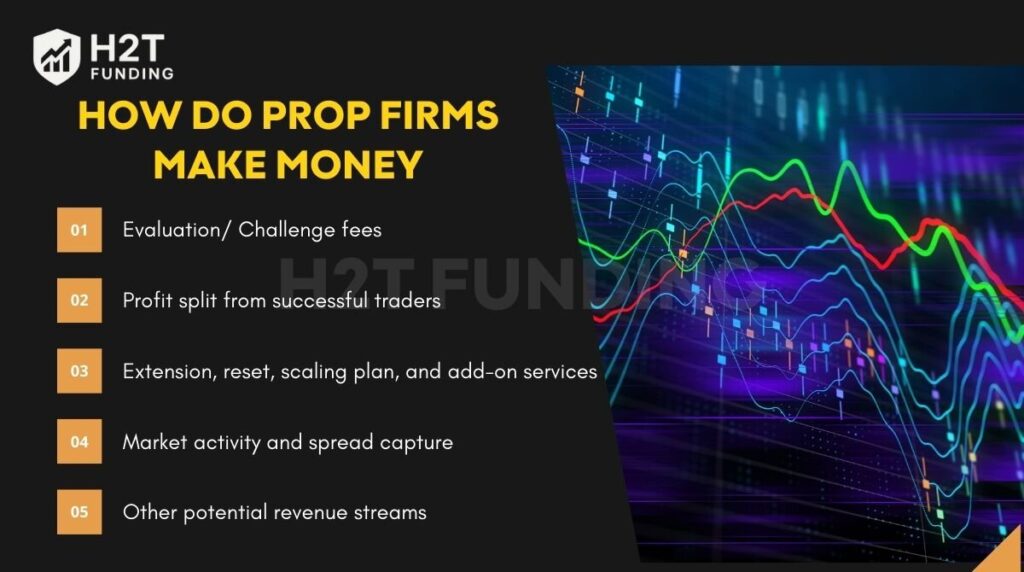
Up next, I’ll break down the primary and supplementary income sources that sustain retail-focused prop firms.
See more:
2.1. Evaluation/ Challenge fees
The evaluation or challenge phase is the primary revenue engine for most retail prop firms. Under the typical multi-step model, traders must hit strict profit targets while staying within drawdown limits before qualifying for a funded account.
- High failure rates: FintechStatistics reports that 90%–95% of applicants fail, meaning most fees stay with the firm without any real capital being risked.
- Recurring attempts: As highlighted by Investetica, many traders who fail reapply multiple times, helping drive an estimated $30 billion in annual evaluation fee losses across the industry.
In short, for much of the sector, these fees are not a side business; they represent the core business model, providing steady, low-risk income that remains completely insulated from market volatility.
2.2. Profit split from successful traders
Once a trader passes the evaluation and enters the funded stage, the firm switches to a profit-sharing model. Typical splits range from 70/30 to 80/20, and in some cases 90/10, with the larger share always going to the trader.
Despite these seemingly generous arrangements, prop firms maintain high profitability because:
- Selection bias: The rigorous evaluation filters ensure only disciplined, consistent performers reach the funded stage, minimizing downside risk for the firm.
- Low payout ratio: Research from QuantVPS shows that only about 7% of funded traders actually receive payouts, indicating that the majority of traders, even once funded, do not generate enough profit or breach risk rules before earning anything.
- Capital preservation: Strict daily and overall drawdown limits further safeguard the firm’s capital, ensuring that profit splits only come from net-positive accounts.
Prop firms profit at this stage by cashing in on the few successful traders, while most either underperform or violate risk parameters, and all of this with minimal exposure to market downside.
2.3. Extension, reset, scaling plan, and add-on services
Beyond the core challenge, prop firms generate substantial revenue through operational and premium service fees that create recurring income streams:
- Extension fees: Traders who need extra time to meet profit targets often pay $50–$150 per extension. For example, FTMO charges €80 (≈ $90) for a 30-day extension. With tens of thousands of traders enrolled, this alone can generate millions in monthly revenue.
- Reset fees: When traders violate rules, they can pay to reset their account and start fresh. Resets typically cost $80–$200 and represent pure profit since no new evaluation infrastructure is required. Fidelcrest, for instance, charges around €129 (≈ $140) per reset, which scales massively across thousands of failed challenges.
- Scaling plans: Some firms charge application or review fees when granting higher capital allocations. Even if only a small percentage qualify, each approval can bring in hundreds of dollars per trader.
- Educational and mentorship programs: Paid webinars, coaching, and courses often range from $200 to over $1,000. For example, The Funded Trader offers premium mentorship programs, turning education into a high-margin revenue source while locking in customer loyalty.
- Platform and data feed fees: Premium charting tools, proprietary indicators, and advanced execution software are often offered at a monthly subscription, adding steady recurring revenue similar to SaaS models.
These add-on fees provide firms with steady recurring income and can contribute millions of dollars annually, independent of whether traders succeed or fail in the market.
2.4. Market activity and spread capture
Some prop firms, particularly those connected to real liquidity providers, can profit from market execution:
- Spread markups: Adding even a 0.2–0.5 pip markup to the real bid-ask spread generates micro-revenue on every trade. For thousands of traders, this quickly snowballs into six-to seven-figure annual profits.
- Commission charges: Although less common, some firms apply a per-trade commission (e.g., $3–$7 per lot).
- Internalization: Firms may mirror or hedge trader positions in the real market. If traders lose while the firm hedges favorably, the firm captures that spread or liquidity rebate.
- Arbitrage & market-making: Advanced firms with algorithmic systems can exploit price discrepancies across markets, adding another layer of profits independent of client results.
By monetizing trading activity itself, firms earn from volume and execution flow, turning every click by traders into incremental revenue.
2.5. Other potential revenue streams
While challenge fees, add-ons, and market activity account for the bulk of income, many prop firms also diversify their business through alternative channels. These strategies ensure stability, reduce reliance on trader success rates, and create recurring revenue even when trading performance is inconsistent.
- Subscription models: Rather than one-time challenge fees, some firms, like BluFX, offer monthly subscriptions ($99–$249+) for platform access and evaluation attempts, ensuring stable recurring revenue.
- Affiliate partnerships: Firms earn $200–$500 cost-per-acquisition (CPA) by referring clients to brokers, data providers, or educational services.
- Retention-based monetization: Structuring rules to encourage repeated account resets rather than long-term funded payouts.
What this reveals is a sophisticated hybrid model where predictable, fee-based income acts as a foundation, while the high-margin profits from elite traders are the upside. This diversification ensures stability for the firm while offering traders a pathway to scale without risking personal capital.
You may also like:
3. How much money do prop firms make from challenges?
Challenge fees are one of the most reliable income streams for modern prop firms. Prices vary by account size, as low as $40 for a $5,000 account and up to $3,000+ for $200,000 – $500,000 accounts.
The profit potential lies in the extremely high failure rate. According to the Traders Union, as many as 95% of prop traders fail, and fewer than 2% manage to keep their funded accounts long-term. That means only a small fraction ever receives funded accounts, while the firm retains the fees from the majority who do not pass.
Example: Topstep charges $99 for a $100,000 Trading Combine (monthly fee). Out of 1,000 applicants:
- ~876 fail -> $99 × 876 = $86,724 in revenue from failed attempts.
- ~124 pass -> some will later break account rules, freeing up capital and making room for new applicants.
Topstep also earns recurring subscription fees since the Combine is billed monthly. If 5,000 traders subscribe at $99/month, that equals $495,000/month in revenue before a single funded payout is made.
For many retail-focused prop firms, these fees, not profit splits, form the bulk of their revenue. This reality leads to a crucial insight: the challenge itself is a meticulously designed product, sold to the masses, just as much as it is a filter for elite talent.
4. Why prop firms remain profitable despite profit sharing?
At first glance, it might seem that giving traders up to 70%, 80%, or even 90% of profits would leave a prop firm with little left over. In reality, their business model is structured so that they remain highly profitable, even when they pay out large profit shares. Several factors make this possible:
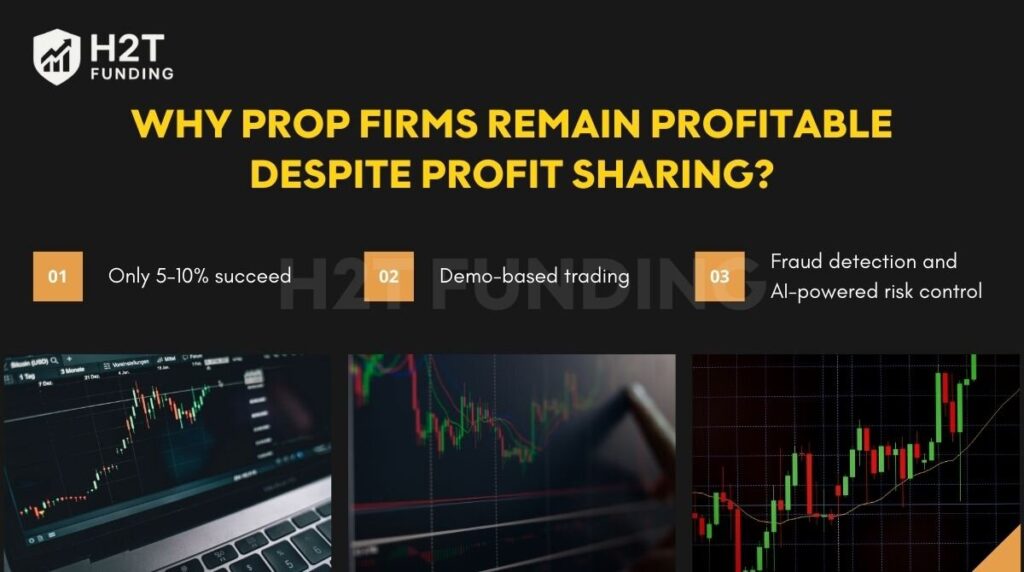
4.1. Extremely low pass rates: Only 5–10% succeed
The evaluation stage acts as a rigorous filter. According to research by QuantVPS, only 5 – 10% of traders manage to pass the evaluation, meaning that 90 – 95% fail to advance. With such a small pool of funded traders, the firm’s total payout obligations are limited.
For example:
- If 1,000 traders pay $500 for a challenge, the firm collects $500,000 upfront.
- Only 50–100 traders pass. Even if each earns $2,000 in a month, the firm’s share (say 20%) is still a healthy $20,000–$40,000, on top of the $500,000 in challenge fees from failed applicants.
This asymmetry means most revenue is secured before any trades are placed.
4.2. Demo-based trading
Here’s one of the industry’s biggest secrets: “funded” doesn’t always mean “live”. The vast majority of prop firms start their funded traders on simulated accounts, not live ones. This has two advantages:
- No real capital at risk for underperforming traders.
- Selective exposure only trades with favorable risk-reward profiles that are mirrored in live accounts.
In practice, this means that a funded trader’s “account balance” may not reflect actual money in the market, allowing the firm to pay out only on profitable results without suffering real market losses.
4.3. Fraud detection and AI-powered risk control
Modern prop firms employ algorithmic monitoring systems and AI tools to detect suspicious patterns, such as:
- Copy trading from external signal providers.
- Data feed exploitation (e.g., latency arbitrage on demo feeds).
- Coordinated trading groups are trying to game the challenge system.
These tools allow firms to disqualify traders who breach terms, protecting their capital and avoiding payouts. In some cases, algorithms also track real-time performance and automatically reduce risk exposure when a trader’s strategy begins to underperform.
The combination of high challenge failure rates, controlled exposure through demo trading, and advanced fraud prevention systems ensures that prop firms can offer generous-sounding profit splits while still maintaining a very favorable profit margin.
Even when a small group of traders earns big, the firm’s structured model keeps overall risk and payout obligations low, making the business sustainable and scalable.
5. How do prop firms make money when you lose?
In the prop trading model, a trader’s loss does not necessarily mean the firm loses money. This raises the question: How do prop trading firms make money even when traders lose? In many cases, these losses actually translate into revenue streams below:
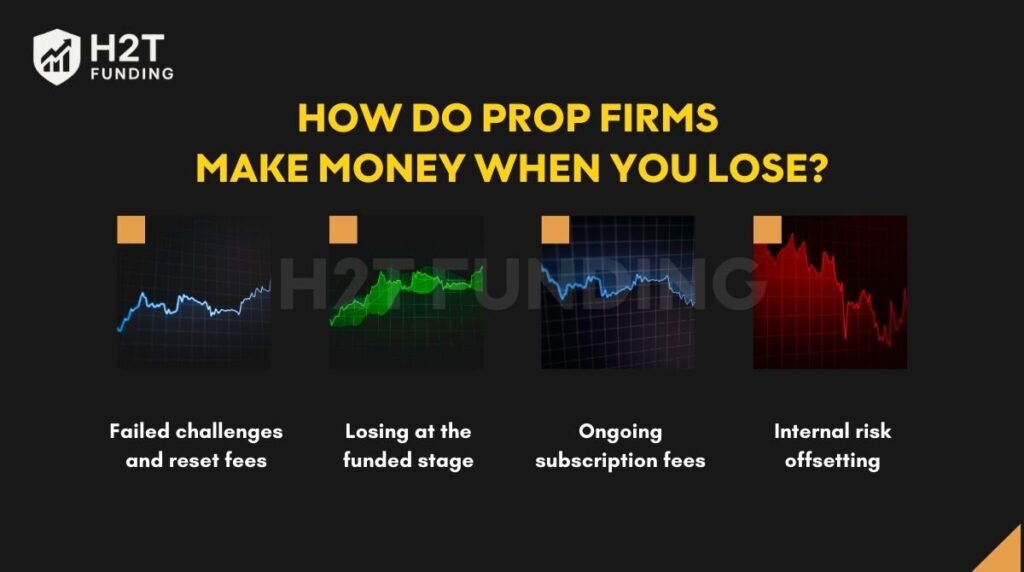
5.1. Failed challenges and reset fees
When traders hit the daily loss limit (often 4–5%) or the total loss limit (8–10%) during the evaluation phase, they fail instantly. To try again, they must purchase a new challenge or pay a reset fee, typically $50–$200, depending on the account size.
For example, if a trader takes the $100K FTMO Challenge, priced at approximately $567, and fails it twice in one month, that nets the firm about $1,134, all without any real capital at risk on their side.
Continue reading:
5.2. Losing at the funded stage
The same strict risk limits apply even after funding. Breaking them results in the immediate loss of the funded account, forcing the trader to go through the evaluation process again. Most of these accounts are demo-based, so the “loss” is simulated rather than real.
5.3. Ongoing subscription fees
I once tried Apex Trader Funding, where the fees are charged monthly, for example, around $297 per month for a $100K evaluation account. At first, the flexibility seemed attractive compared to a one-time challenge fee.
However, even after I lost access to the funded account, the payments continued if I wanted to keep the platform and data access. That experience showed me how the subscription model can end up being far more costly than a one-time challenge,
5.4. Internal risk offsetting
In cases where live accounts are used, one trader’s loss can be offset by another trader’s profit through risk-netting mechanisms, allowing the firm to remain profitable overall.
Every trader’s loss can still generate income for the prop firm, whether through repeated challenge fees, resets, subscriptions, or internal risk management strategies. This ensures the firm remains profitable even when the majority of traders fail.
6. Is the prop firm business model truly transparent?
When considering a prop trading firm, transparency isn’t just preferred; it’s essential. Traders deserve clarity around operations, fees, rules, and promises. The following cases and community insights shed light on why transparency matters and how to identify a trustworthy firm.
6.1. Notable legal cases
In recent years, the proprietary trading sector has faced mounting scrutiny over transparency and fairness. While many firms operate legitimately, high-profile disputes have revealed how regulatory actions and poor governance can damage both trader trust and firm reputations. Two notable examples, My Forex Funds and True Forex Funds, showcase the stakes involved.
My Forex Funds (Traders Global Group)
In 2023, the U.S. Commodity Futures Trading Commission (CFTC) accused My Forex Funds of operating a fraudulent scheme that collected over $310 million in fees. However, the case took a dramatic turn. A U.S. federal judge ultimately dismissed the lawsuit with prejudice, a rare move indicating the case cannot be refiled.
The dismissal followed a scathing report from a court-appointed Special Master, who found that the CFTC had acted in “bad faith” by misrepresenting evidence and withholding crucial information from the court. A key piece of misrepresented evidence was a C$31.5 million transfer, which the CFTC claimed was fraudulent but was later proven to be a legitimate tax payment.
As a result, the court sanctioned the CFTC, ordering the regulator to pay My Forex Funds’ significant legal fees. This case highlights the potential for severe regulatory overreach and the importance of due process.
True Forex Funds
The downfall of Hungary-based True Forex Funds was triggered by a different kind of operational risk. In February 2024, the firm abruptly ceased operations after MetaQuotes, the developer of the MT4 and MT5 platforms, terminated its licenses.
This was part of a broader crackdown by MetaQuotes on prop firms that used third-party, unregulated brokers to provide trading technology, which violated MetaQuotes’ updated usage policies.
While True Forex Funds was also on the CFTC’s “RED List” for serving U.S. clients without registration, the license termination was the direct cause of its initial shutdown. The company attempted to relaunch on other platforms but failed to recover.
In May 2024, it announced its permanent closure due to “financial insolvency,” leaving many traders with pending payouts. This case underscores a firm’s critical dependence on its technology providers and the risks associated with its underlying brokerage structure.
These cases underscore that even large, well-known prop firms can face serious legal and operational challenges. Traders should conduct thorough due diligence, verify a firm’s regulatory status, and review payout histories before committing to any challenge or funded account program.
6.2. Controversies surrounding demo accounts, delayed or unclear withdrawals
One of the biggest complaints about many prop firms is that traders often work on demo (simulated) accounts, even after they “pass” the challenge and become funded. This means the trades are not placed in the real market; instead, they are simulated on the firm’s servers. While this helps prop firms control risk, some traders feel misled because they believed they were trading real company money.
Payout delays are another major frustration. Many traders expect quick withdrawals, but in reality, it can take much longer. As one trader wrote:
“Been about a week since I requested the payout, and it’s been ‘under review’ for 5 days. When I contacted support, they just basically said it should only take 2 days, but this is part of the normal process (contradiction, but whatever). Anybody else experiencing this?” — Swearimnatural, Reddit
“Funding Pips play tricks to delay payouts?
PS: Because some of you asked.
I had received about 10 consecutive payouts on the same account.
Earlier, I was risking the max Daily DD on trades, but recently, only risking less than 1% a day.
I do not believe FP is genuine about these interviews. Most probably, they want to delay the payouts or just avoid them altogether.
As I suspect, after the interview, they might say, You are too risky and not consistent enough for us and ban you from trading with FP, and payout is rejected.
Some other firms have done similar things in the past, ex. TFT, Goat fund, FCF, Bespoke Funding…” – Chandana Piyaratne – Facebook
Some firms add extra verification steps or suddenly apply new rules before sending payouts, making traders feel like the firm is trying to avoid paying. In other cases, the rules for payouts are not clear from the start, leaving traders confused about why their profits are withheld.
In short, while demo trading and payout checks can be part of a normal process, the lack of transparency and slow communication often creates distrust and gives the impression that some prop firms rely more on challenge fees than on real market profits.
6.3. How to identify a reputable prop firm
Not all prop firms operate with the same level of fairness and transparency. Some genuinely want traders to succeed, while others profit mainly from fees and failed challenges.
- Clear and consistent rules for trading, risk limits, and payouts.
- Transparent disclosure on whether accounts are live or demo.
- Proven record of paying traders on time, with minimal payout disputes.
- Positive feedback from verified traders across multiple review platforms.
- No major unresolved legal issues or frequent rule changes.
- Use of licensed, reputable trading platforms like MetaTrader or cTrader.
- Accessible and responsive customer support that provides clear answers.
- At least a moderate operating history, showing long-term stability.
A reliable prop firm should earn alongside you, not just profit from your mistakes. If you notice that a firm gains more from traders failing than succeeding, that’s a clear red flag. Before committing, take time to read through detailed prop firm reviews to identify which firms truly align their success with yours.
7. Benefits & risks of joining a prop firm
Prop trading opens the door to significant earning potential and professional growth, but it also imposes strict rules and psychological challenges. Understanding both sides of the equation is essential before committing to this model.
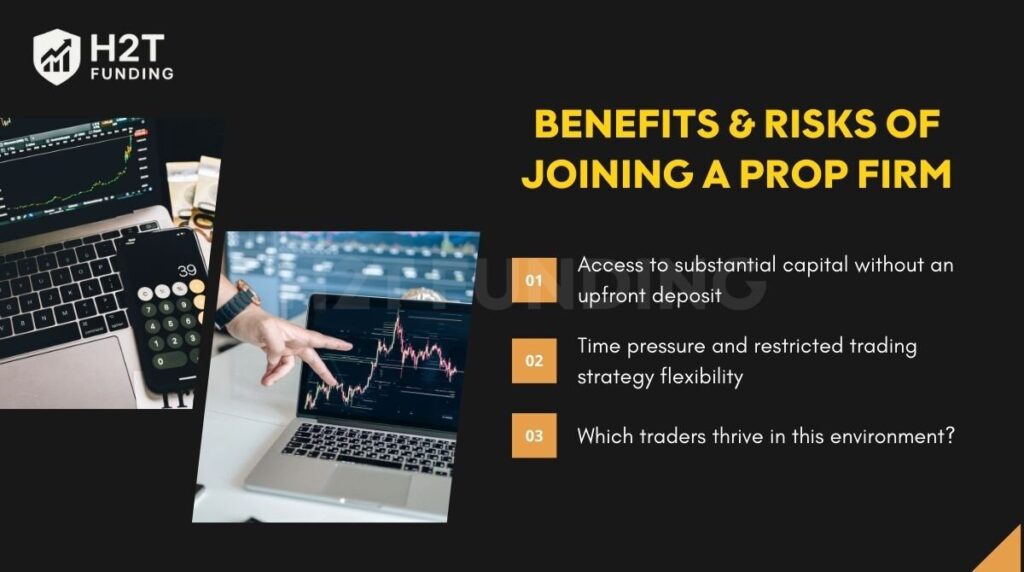
7.1. Access to substantial capital without an upfront deposit
Many independent traders struggle to scale their strategies due to limited personal funds. Prop firms solve this problem by granting access to large trading accounts, sometimes in the six-figure range, without requiring a security deposit.
For example, a trader earning 5 % on a $100,000 funded account pockets $5,000, compared to just $500 on a $10,000 personal account.
7.2. Time pressure and restricted trading strategy flexibility
Most prop firms enforce strict evaluation timelines, often requiring traders to hit profit targets within 30–60 days while respecting tight drawdown limits. These constraints can force traders into more aggressive strategies than they would normally use.
Additionally, certain trading styles, such as news trading, high-frequency scalping, or holding positions over weekends, are sometimes prohibited. Combined with performance pressure, these rules can be mentally draining, leading to stress and burnout for those unprepared.
7.3. Which traders thrive in this environment?
Prop firm trading is best suited for individuals who:
- Possess strong discipline and consistently follow a tested strategy.
- Lack large amounts of personal capital but are ready to scale up.
- Perform well under structured rules and accountability systems.
- Maintain psychological resilience in high-pressure situations.
Prop firms provide ambitious traders with a shortcut to higher earning potential by offering substantial capital and a professional trading framework. However, the opportunity comes with strict rules, performance deadlines, and mental strain.
For disciplined traders who can adapt quickly, this environment can be a career accelerator; for others, it may feel more like a constraint than an advantage.
8. Community discussions
Prop firms are a hot topic across trading forums and Reddit, where traders frequently share experiences, ask questions, and voice concerns. These conversations provide valuable insight into how people perceive the industry, highlighting both curiosity and skepticism.
One recurring question revolves around the source of capital that prop firms use. A Reddit user wrote:
“Where do prop funds get their money from? I am curious about prop funds and interested in getting funded. I was curious where they get their money? Does it like come from the bank or some sort of private equity? Or those guys made so much money from trading that they use their own money to fund people?” — mateyman, Reddit
Such questions reflect the uncertainty many newcomers have about whether prop firms truly back trades with real money or rely mainly on fees from failed challenges. While established firms often pool revenue from evaluation fees, subscriptions, and selective profit sharing, others may operate largely on simulated accounts, which fuels ongoing debate in the community.
These discussions highlight the importance of due diligence before choosing a prop firm. Traders are encouraged to research legal standing, payout histories, and platform reliability to distinguish credible firms from those primarily designed to profit from evaluations.
9. FAQs
Not always. Most retail prop firms place traders on demo accounts while charging for evaluations. Only a small fraction of trades from top-performing traders may be mirrored with real capital.
Yes, most prop firms operate legally, but transparency varies. Some have faced lawsuits over fraud or delayed payouts, so it’s important to check their licenses, community reviews, and payment history.
If you have a skill but lack capital, joining a prop firm can be a good opportunity. If you prefer full freedom over your strategy and don’t want to share profits, trading with your own money may be the better option.
Look for transparency in payout policies, verified trader reviews, and a clean legal record. Reputable firms clearly outline rules, have proven payout histories, and avoid unrealistic profit promises.
No. Unlike Ponzi or pyramid schemes, prop firms don’t pay old participants with new fees. However, some firms rely too heavily on challenge fees without truly backing trades, which raises concerns about sustainability.
They enforce strict risk rules such as daily drawdowns and maximum loss limits. This ensures that most traders fail before they can access large accounts, keeping the firm’s real capital safe.
Prop firms earn mainly from evaluation fees, resets, and subscriptions. A smaller share comes from profit splits with successful traders. Some also generate income from spreads, data sales, or educational products.
Traders don’t risk their own money; the prop firm covers losses and manages risk through strict rules and limits, ensuring only disciplined traders trade with real capital.
10. Conclusion
Proprietary trading firms generate revenue through challenge fees, subscriptions, and profit-sharing with successful traders. While many earn most from failed challenges, the profit-split model lets them celebrate your wins too.
So, what’s the final verdict? If you’ve ever wondered how do prop firms make money, the truth is inspiring: it’s not just about profits, but about partnership. Traders bring skill, firms provide leverage, and together they can achieve remarkable success, turning ambition into real opportunity.
When you are considering joining a prop firm, start by carefully reviewing its rules, payout conditions, and transparency. Always choose reputable companies to avoid disappointment. For trusted recommendations and detailed insights, feel free to leave a comment below or explore our prop firm review.
For more insights on proprietary trading and proven strategies, explore other articles in H2T Funding’s Prop Firm & Trading Strategies section.

